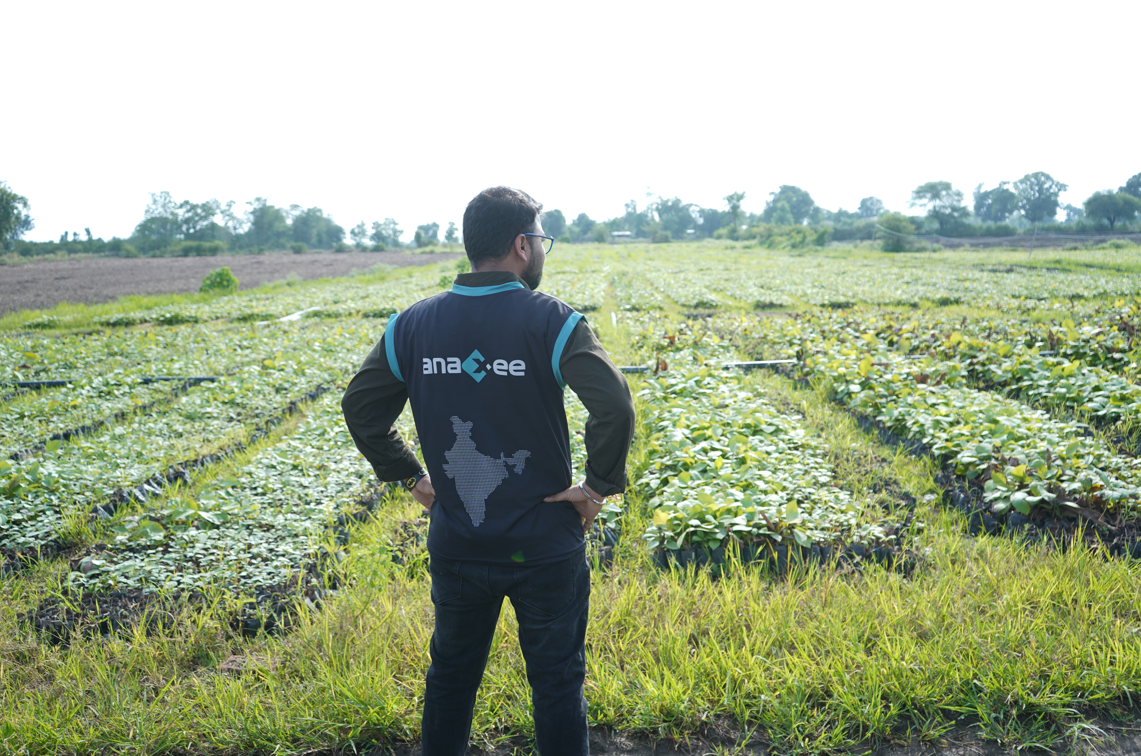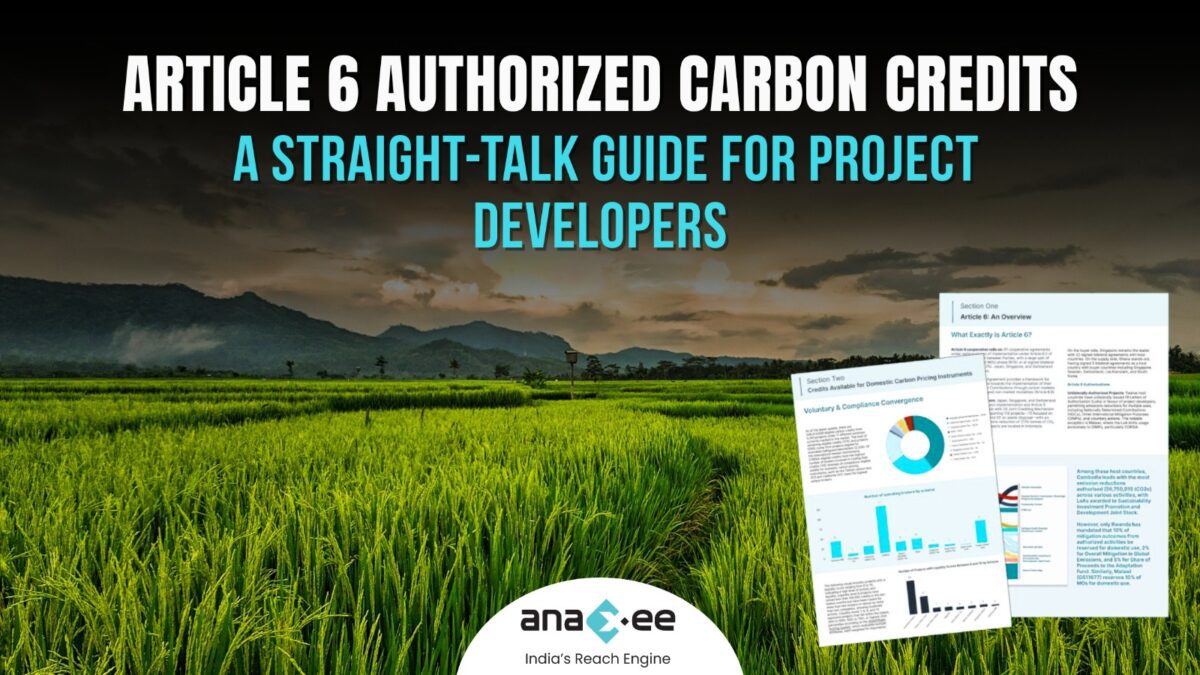Article 6 Authorized Carbon Credits: A Straight-Talk Guide for Indian Project Developers
1. Why This Matters (Quick Intro)
Climate finance is changing fast. After COP 28, everybody keeps hearing “Article 6”. The term sounds complicated, but in simple words it is just a new rulebook under the Paris Agreement that lets one country, company or airline use carbon reductions achieved in another country- as long as everyone counts them only once.
For small and mid-size project developers in India, this change opens two big doors:
-
Higher Prices. Buyers pay a premium for credits that carry an Article 6 “authorized” tag because these units come with extra proof that no one else—especially the host government—will double-count them.
-
New Markets. Compliance schemes like CORSIA (for airlines) have moved from trial to Phase 1 in 2025. Those schemes accept only Article 6 authorized credits from recognised standards such as Gold Standard.
Anaxee, with 50 000+ Digital Runners collecting field data across 11 000 pin codes, is perfectly placed to help rural projects grab this premium. This guide explains the mechanics in plain English and lays out a step-by-step action list for Indian developers, NGOs, and community groups.
2. What Exactly Is Article 6?
2.1 The Short Version
– Article 6.2 lets two or more governments trade “ITMOs” (Internationally Transferred Mitigation Outcomes). Think of an ITMO as a carbon token that carries a government signature.
– Article 6.4 will create a UN-run crediting mechanism (something like the old CDM 2.0), but rule-writing is still stuck after COP 28.
– Both tracks insist that the host country must apply a corresponding adjustment—an accounting correction in its national inventory—so the same tonne of CO₂ is not claimed twice.
2.2 Why COP 28 Still Matters, Even Without Final Text
Negotiators in Dubai failed to finalise the 6.2 and 6.4 guidance, but real-world deals kept moving:
– Thailand and Switzerland executed the first government-to-government ITMO transfer.
– Gold Standard awarded the first “Article 6 authorized” labels to cookstove projects in Rwanda (Atmosfair) and Malawi (Hestian).
– Airlines entering CORSIA Phase 1 (2024–2026) confirmed they will only buy authorized credits.
Take-away: waiting for perfect UN text means losing time. Early movers are already locking supply agreements.
3. The New Buzzword: “Authorized” Credits
Authorized credit = ordinary carbon credit + official permission letter (LOA)
-
Letter of Authorization (LOA). The host government signs a document saying:
-
Project X may transfer Y tonnes for purpose Z (NDC, CORSIA, or other).
-
The government will adjust its own greenhouse-gas inventory accordingly.
-
-
Label in Registry. A recognised standard (e.g., Gold Standard) attaches a digital tag to each issued credit, showing which purpose(s) it can serve.
-
Transparency Gate. Registries stop users from retiring credits for purposes not covered by the LOA.
Because of the extra vetting, these credits normally sell at a 20–40 % premium over standard voluntary units—sometimes more when supply is tight.
4. Inside the Gold Standard Framework (2025 Edition)
Gold Standard upgraded its registry in three key ways:
| Feature | Why It Matters |
| Multi-purpose tag (“Compliance”, “CORSIA”, “Other”) | Shows exactly which market you can use the credit in. |
| Separate flag for “Corresponding Adjustment Applied” | Buyers see if the host government has completed the bookkeeping yet. |
| Public upload of each LOA | Total transparency- anyone can download the letter. |
For Indian developers, choosing Gold Standard means:
– Faster market access (CORSIA will recognise GS once final administrative sign-off lands later in 2025).
– Strong SDG tracking—important for CSR-driven buyers.
– Compatibility with existing methodologies (cookstoves, agroforestry, bio-char, bundled smallholder projects, etc.).
5. Market Signals You Can’t Ignore in 2025
-
Airlines Need Millions of Tonnes. IATA projects CORSIA Phase 1 demand at 200–250 million tonnes; supply of authorized units is still under 20 million. Math is simple: shortage = higher prices.
-
Corporate “Net-Zero” Police Are Tightening. The Voluntary Carbon Market Integrity Initiative (VCMI) and Science Based Targets initiative (SBTi) now nudge big brands toward Article 6 aligned credits for headline claims.
-
Southeast Asian Buyers Are Active. Singapore’s carbon tax allows regulated companies to surrender up to 5 % of taxable emissions using Article 6 authorized credits from accepted standards—Gold Standard included.
6. Where Does India Stand?
6.1 Policy Snapshot
| Item | Status (July 2025) |
| Carbon Credit Trading Scheme (CCTS) | Pilot auctions under way; Article 6 alignment planned for 2026 roll-out. |
| Designated National Authority (DNA) | Re-notified under MoEFCC; draft LOA template circulated for comments. |
| Positive List | Energy efficiency, renewable micro-grids, agroforestry, clean cooking expected to feature. |
6.2 What This Means for Rural Projects
– States like Madhya Pradesh, Odisha, and Jharkhand, where household biomass use is high, can become cookstove powerhouses- exactly like Rwanda’s example.
– Bund plantation models (Verra VM0047) can gain extra funding if authorized, because the buyer receives a compliance-eligible tonne rather than a voluntary one.
7. Why Anaxee Has a Built-in Advantage
-
Last-Mile Data Capture. Digital Runners already visit rural households; adding stove usage surveys or tree-survival checks needs zero new hiring.
-
Tech + Trust. Mobile app timestamping plus periodic drone fly-overs (sensor data pushed to an immutable ledger) offers verifiers bullet-proof evidence—exactly the traceability Gold Standard loves.
-
Scale at Speed. 50 000 runners across 540+ districts can implement identical protocols nationwide, giving India the scale factor every government official craves.
8. Step-by-Step Action Plan for Indian Developers
| Step | What to Do | Time | Tip |
| 1 | Feasibility Check – match your project idea to India’s draft positive list. | 1 week | Use Anaxee’s district-level data to pick clusters. |
| 2 | Choose Standard & Methodology. | 2 weeks | Gold Standard or Verra; pick one with proven MRV. |
| 3 | Stakeholder Consultation. | 4 weeks | Leverage Anaxee field crews to hold village meetings. |
| 4 | Prepare Project Design Document (PDD). | 6 weeks | Keep language simple; highlight SDG co-benefits. |
| 5 | Submit LOA Request to DNA. | 1–4 months | Attach letters of support from state authorities to speed things up. |
| 6 | Validation & Gold Standard Review. | 3–5 months | Provide raw field data through Anaxee’s platform. |
| 7 | Issuance & Labeling. | 1 month | Check that all three tags (Compliance, CORSIA, Other) appear as intended. |
| 8 | Market & Sell. | Ongoing | Target airline and Singapore-based buyers for best price. |
Total timeline: as quick as 9 months for a straightforward cookstove bundle.
9. Risks & Reality Checks
– Revocation Risk. Host governments can, in theory, cancel an LOA. Mitigate by aligning with national priorities and maintaining clear communication channels.
– Price Fluctuation. Premium today doesn’t guarantee tomorrow. Hedge by locking multi-year offtake deals.
– Methodology Upgrades. If Article 6.4 UN rules introduce stricter baselines, be ready to update MRV. Continuous monitoring by Digital Runners acts as built-in safeguard.
10. Final Thoughts
Article 6 is no longer a future concept. Credits with the right authorization stamp are already trading, and compliance buyers are hunting for scalable, trustworthy supply. India can become a major source- if project owners act now.
Anaxee stands ready to plug your rural project into this premium pipeline with rapid data collection, tech validation, and transparent reporting. Contact our Tech for Climate team today, and let’s turn global rules into rural rewards.



